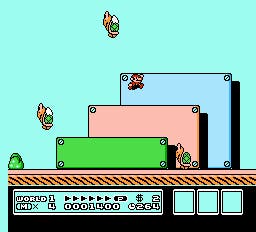Retrospective: Super Mario Bros. 3
Running and jumping.
In the winter of 1991, my occasional friend and full-time next-door neighbour George hit the bacterial lottery, coming down with an astonishingly rare case of lyme borreliosis, also known as Lyme disease, also known as Bad News, George, This is Going to Hurt. You know you have Lyme disease when you start to get strange circular rashes, when they give way to soreness, fever, and malaise, and when these elements finally develop into shooting pains, memory loss, and, very occasionally, facial palsy.
That's the theory, anyway. George didn't pick up on any of these symptoms because he was spending far too much time in the company of a plumber. He simply didn't notice his joints giving in, his mind falling apart. I remember watching from our living room window as George's family finally bundled him off to hospital. His parents looked frantic, his brothers were subdued. Even their cat looked unhappy. I, meanwhile, was furiously jealous, obviously, leaning my head against the frosty pane, thinking, Lucky you, George. A long, contagious winter with nobody to share the TV with. Six weeks of recuperation and uninterrupted access to Super Mario Bros. 3.
Let me explain. Back then, Super Mario wasn't my favourite videogame character, he was videogames. My friends and I were students of Mario in the early 1990s, professors of Mariology, and we spent our days in rambling scholarly discussions about the intricacies of his worlds, the peculiar richness of their secrets, and whether he could have Luigi in a fight. (He probably could, incidentally, but he would feel bad about it afterwards.)

We debated everything, from the safest means of defeating diagonal Bullet Bills to the identity of whoever might have built the Mushroom Kingdom's handy yet mysterious system of warp pipes. We had our favourite levels, and we argued their merits, often bitterly. My friend Ruth could play all of 8-4 in the first game with her back to the TV, platforming by audio alone, and she wasn't considered even faintly deranged: she was entirely normal by our standards, and blind precision jumping was seen as being a fairly standard skill to possess. We weren't alone, either. It turns out that people like Salman Rushdie enjoyed the Mario Bros. games - although I'm assuming he had to play them with the sound down.
Given our deep, sympathetic understanding of Mario, I'd like to think that we instinctively knew that the otherwise wonderful Super Mario Bros. 2 wasn't quite right, with its ambling ostriches and flying carpets, even if we didn't know it was actually a localised and tweaked version of Doki Doki Panic. Equally, I'd like to think that we'd have instinctively known that the Japanese Super Mario 2 - not that we got it at the time - riddled with sudden winds and an over-reliance on hidden platforms, wasn't the team handing in their best work. Either way, that made for a long run, from the delights of the first Super Mario Bros. in 1987, though to the UK release of Super Mario Bros. 3 at the tail end of the summer in 1991, where we hadn't had much in the way of authentic top-class plumber brilliance.
Mario 3 delivered. Super Mario World might just inch it in terms of being the greatest 2D platformer of all time, but the NES' swansong still had its own range of best-evers: the best ever packaging (in my opinion), the best ever advert, with its depiction of an entire planet craving the return of its dungareed hero, and the best ever incidence of product placement in a Fred Savage movie.








